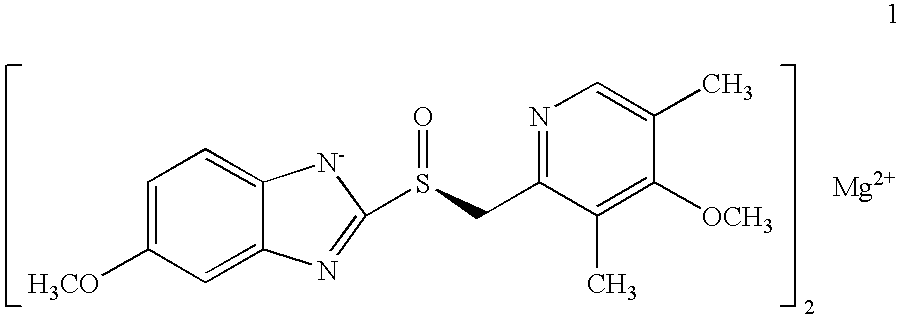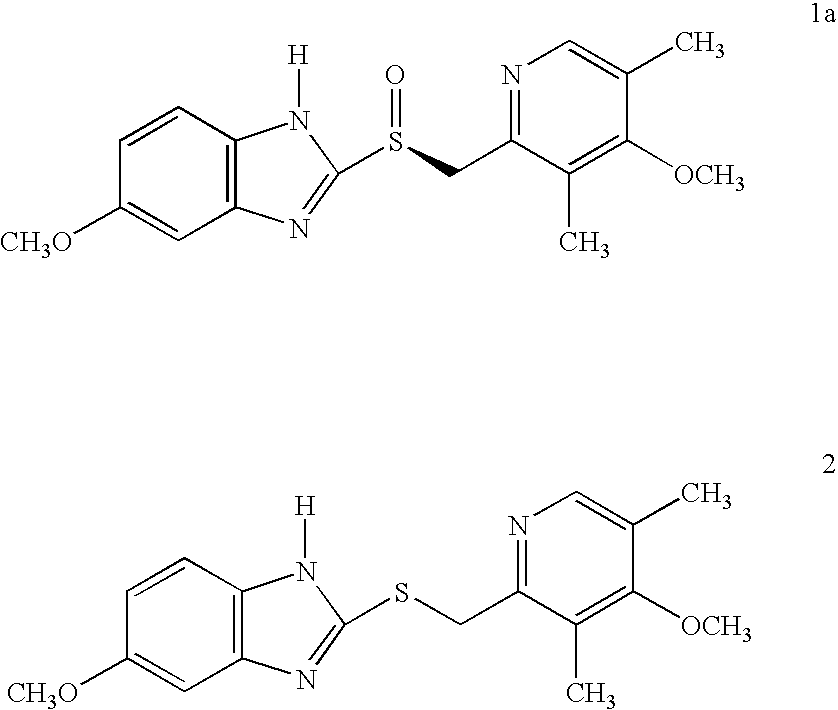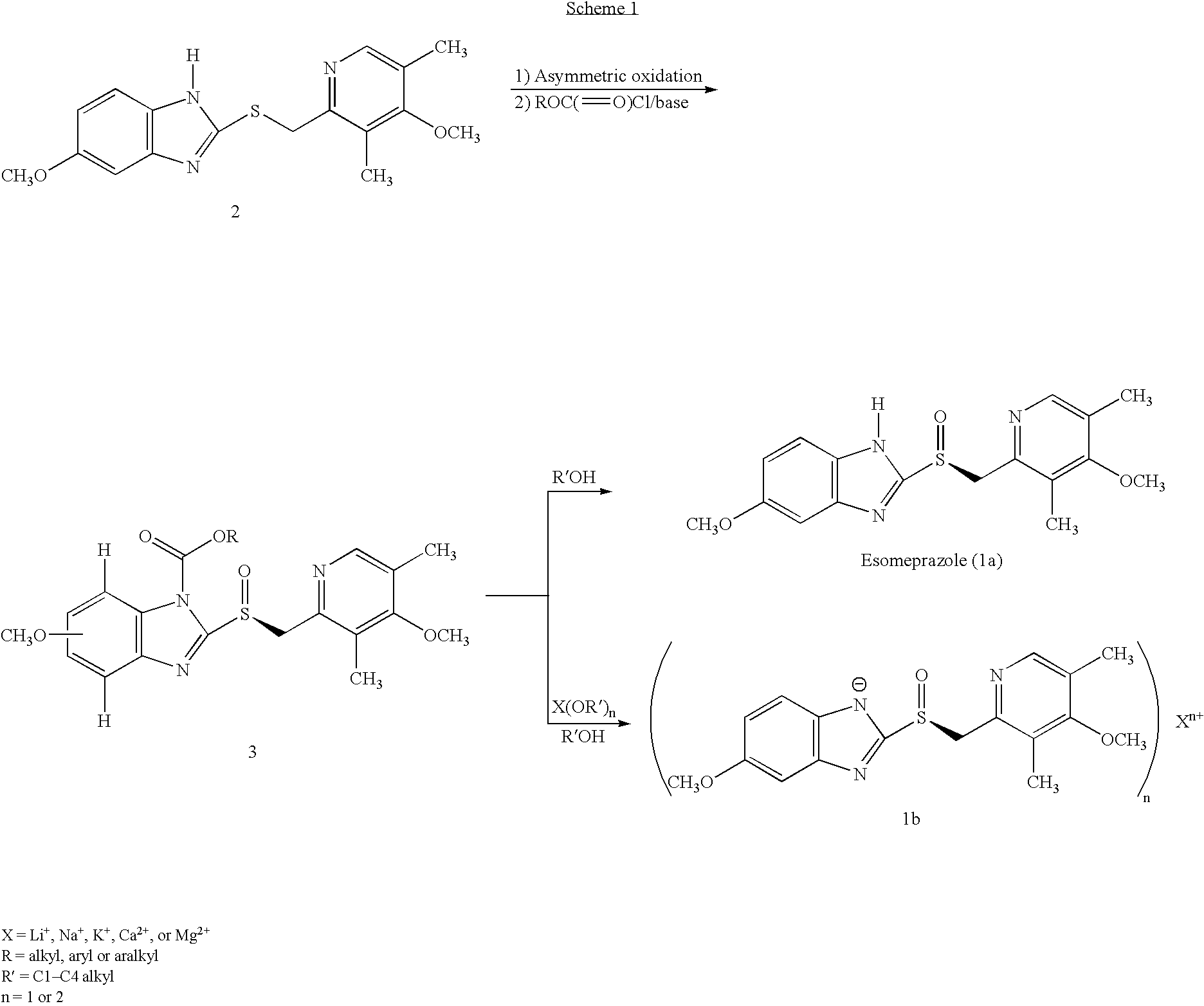Process for the preparation of esomeprazole and salts thereof
a technology which is applied in the field of process for the preparation of esomeprazole and salt thereof, can solve the problems of multiple steps, low (less than 50% on average) chemical yield, and various deficiencies of the process, so as to avoid isolating unstable omeprazole and increase yield
- Summary
- Abstract
- Description
- Claims
- Application Information
AI Technical Summary
Benefits of technology
Problems solved by technology
Method used
Image
Examples
example 1
Preparation of (S)-5 / 6-methoxy-1-benzyloxycarbonyl-2-[[(4-methoxy-3,5-dimethyl-2-pyridinyl)methyl]sulfinyl]-1H-benzimidazole
[0073]To a solution of 2-[2-(3,5-dimethyl-4-methoxypyridyl)methylthio]-5-methoxy-benzimidazole 2 (10 g) in 50.0 mL toluene under an inert atmosphere, was added (D)-diethyl tartrate (2.75 g). The mixture was heated to 50-55° C. and stirred for 30 minutes. Titanium (IV) isopropoxide (1.73 g) was added and the temperature was maintained at 50-55° C. for an additional 60 minutes. The reaction mixture was cooled to 0-5° C. whereupon diisopropylethylamine (1.33 g) and 80% cumene hydroperoxide (6.93 g) were added while keeping the temperature below 10° C. The reaction mixture was stirred at 0-10° C. for 2-4 hours until the reaction was complete. The reaction mixture was warmed to room temperature, filtered through Celite™ and extracted with 12-14% ammonium hydroxide. The aqueous and methyl isobutyl ketone (MIBK, 30 mL) phases were cooled to 0-5° C. The pH was adjusted...
example 2
Preparation of Amorphous Esomeprazole Magnesium Salt (1)
[0077]Magnesium metal (0.26 g) was added to methanol (60 mL) and stirred at room temperature for 3-4 hours. To the mixture was added (S)-5 / 6-methoxy-3-benzyloxycarbonyl-2-[[4-methoxy-3,5-dimethyl-2-pyridinyl)-methyl]sulfinyl]-1H-benzimidazole (10 g ˜1:1 of 5- and 6-methoxy compounds) in portions. After stirring for 20-30 minutes the methanol was evaporated to a small volume and ethyl acetate was added, which caused precipitation. The damp cake obtained by filtration was pulped in ethyl acetate for 2-3 hours. The cake obtained by filtration was vacuum-dried to afford optically pure esomeprazole magnesium salt. X-ray powder diffraction pattern demonstrated the amorphous nature of the product. Weight: 7.1 g (75% overall yield). Purity: 99.3% by HPLC. Chiral purity: 99.2% (S-form) by HPLC. Mg content: 3.4%. Analytical data were consistent with that from the prior art.
example 3
Preparation of 5 / 6-methoxy-1benzyloxycarbonyl-2-[[(4-methoxy-3,5-dimethyl-2-pyridinyl)methyl]sulfinyl]-1H-benzimidazole
[0078]To a solution of 5-methoxy-2-[(4-methoxy-3,5-dimethylpyridin-2-yl)methylthio]-1H-benzimidazole (30 g) in dichloromethane (165 mL) at 0-5° C., under an inert atmosphere, was added meta-chloroperbenzoic acid (0.95 eq) over 10 minutes. The mixture was stirred for 10-15 minutes. To the reaction was added 12% ammonium hydroxide (180 mL). The layers were separated. The organic layer was extracted with 12% ammonium hydroxide (2×180 mL). The combined aqueous layers were washed with toluene (90 mL). To the aqueous layer was added dichloromethane (120 mL) and the mixture was cooled to 0-5° C. The pH was adjusted to pH=8.5-9.5 using 50% aqueous acetic acid. The layers were separated. The aqueous layer was extracted with dichloromethane (2×90 mL). The combined organic layers were washed with brine (30 mL), dried over sodium sulfate, filtered through celite and vacuum dist...
PUM
| Property | Measurement | Unit |
|---|---|---|
| enantiomeric excess | aaaaa | aaaaa |
| temperature | aaaaa | aaaaa |
| temperature | aaaaa | aaaaa |
Abstract
Description
Claims
Application Information
 Login to View More
Login to View More - R&D
- Intellectual Property
- Life Sciences
- Materials
- Tech Scout
- Unparalleled Data Quality
- Higher Quality Content
- 60% Fewer Hallucinations
Browse by: Latest US Patents, China's latest patents, Technical Efficacy Thesaurus, Application Domain, Technology Topic, Popular Technical Reports.
© 2025 PatSnap. All rights reserved.Legal|Privacy policy|Modern Slavery Act Transparency Statement|Sitemap|About US| Contact US: help@patsnap.com



